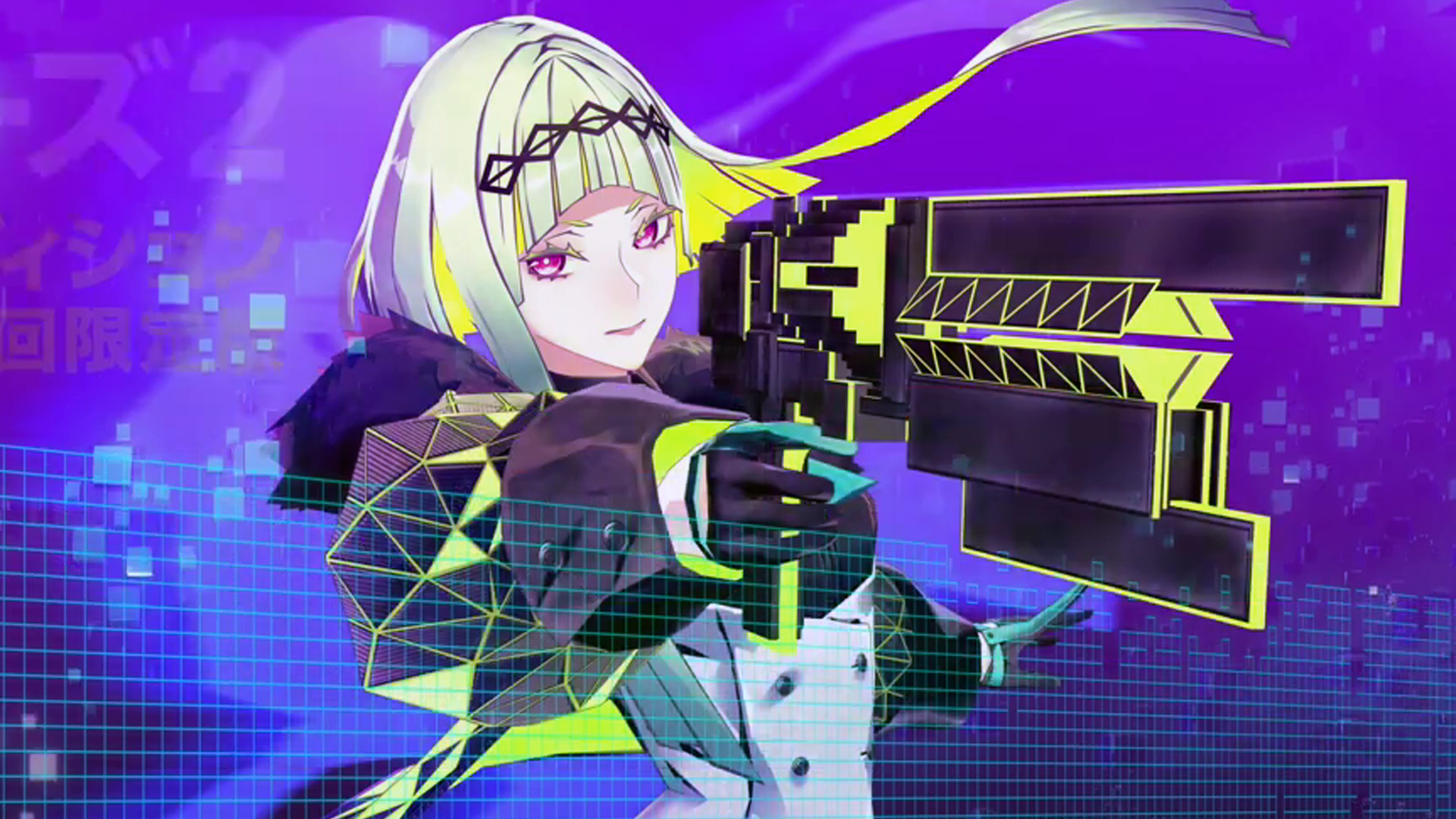From the very beginning, Soul Hackers 2 makes it clear that it’s not interested in wasting time. Within the first two hours of starting up Atlus’s latest JRPG, you’ll have all of your main party members, know the focal points of the story, and have a grasp on almost all of the primary gameplay mechanics. It’s a refreshing and stark contrast to the “slow-burn” kind of gameplay JRPGs are known for, and a very different approach than fans of the larger Shin Megami Tensei series might be used to. It’s clear, then, that the goal of Soul Hackers 2 is to forge a new SMT subseries with a distinct approach to gameplay–a goal which it largely succeeds at.
In the future, mankind is stuck in a rut: Technological and social progress has stalled, and the human race faces a sort of global ennui. Beneath the outer fabric of society, however, groups of gifted humans who can communicate with the supernatural world work underground as “Devil Summoners.” Some, like the Yatagarasu organization, aim to use their powers to protect humanity, while the nefarious Phantom Society aims for global destruction. In the middle of this conflict, Aion–a sentient AI born from the collective of networked digital knowledge–gives form to two physical “agents,” Ringo and Fugue, sending them on a mission to rescue the world from certain destruction.
Soul Hackers 2, despite its name and numbering, bears only a few elements in common with the original Shin Megami Tensei: Soul Hackers, namely a cyberpunk-influenced worldview, a villainous group called the Phantom Society, a character belonging to the Kuzunoha family, and the concept of interacting with the souls of the dead through “hacking.” Ringo and Fugue are dismayed to immediately discover that most of the folks Aion has tasked them with protecting are recently deceased, and so Ringo re-imbues them with life through the “Soul Hack.” This intertwines their souls with her digital lifeforce and bonds her to them for the course of the game, both story- and gameplay-wise.
From the outset, Soul Hackers 2 oozes style. Ringo and her three primary companions–diligent and devoted Yatagarasu agent Arrow, Phantom Society femme fatale Milady, and the old-fashioned mob gangster-inspired freelance Devil Summoner Saizo–have striking character designs and personalities that make them immediately memorable and endearing. The main characters and primary NPCs are designed by famed Japanese manga artist and illustrator Shirow Miwa, who imbues the designs with a strikingly sharp, colorful style and grace that feels right at home in the neon-lit underground cyberpunk city they inhabit.
The slick feel of the visual design carries over into the fast and intuitive turn-based combat. Each character equips a summoned demon onto their COMP weapon, which determines their combat skillset and resistance/weakness array, similar to how the titular Personas work in that series. Rather than stunning or gaining extra turns when an enemy weakness is hit, you instead put one of your demons in the “stack.” At the end of the player turn, the stacked demons perform a mass attack called a sabbath, doing additional damage and potentially activating other effects against all of the enemies on the field. While this new system does temper strategy somewhat compared to other SMT titles (there’s no disadvantage to your party’s weaknesses being hit beyond suffering extra damage), it does make combat move a lot more quickly. The series’ staple gameplay element of demon negotiation has been moved outside of battle, and there’s even a single-button shortcut to attack an enemy’s known weakness to really streamline things.
It’s clear that the goal of Soul Hackers 2 is to forge a new SMT subseries with a distinct approach to gameplay–a goal which it largely succeeds at.
That’s not to say there’s no strategy involved, however. Ringo has special Command Skills she can call upon to perform actions like change a party member’s equipped demon or consolidate all stack damage onto a single target. Party members have unique skills and affinities that can be altered by upgrading their COMP weapon and equipping enhancement items called Mistiques. Finally, there are numerous combat enhancements that are unlocked by progressing through both the main and side narratives, all of which can help turn the tide of combat in your favor.
The progression of Soul Hackers 2 is divided into sequences advancing the main story and a myriad of optional side quests. The central macguffins of Soul Hackers 2 are the Covenants, a sort of life-energy that, when collected and consolidated, can call upon a Great One to remake the world. Much of the main story will be spent chasing these Covenants and their holders in straightforward dungeon/boss/story cinematic sequences. However, it wouldn’t be an exaggeration to say that side quests and optional areas in Soul Hackers 2 are half of the game, and a player would be missing out on a lot of content by skipping them.
Ringo, now bound to the souls of her teammates, earns rapport with them in the form of points throughout the game. This happens not only through mandatory story events, but by completing optional missions taken at a club, chatting with party members at the bar over drinks, and eating food at the team’s safehouse HQ. As Ringo’s bonds with her teammates deepen, she opens up their “Soul Matrix”–a dungeon area representing their psyche that can be explored. The further into each member’s Soul Matrix Ringo delves, the more helpful abilities for exploration and combat open up to her–not to mention the usual loot and experience you’d expect from dungeon-crawling.
But for a representation of a person’s inner psyche, the Soul Matrix is visually underwhelming–it’s mostly glowing cubes as far as the eye can see. This is a problem that persists throughout the dungeons of Soul Hackers 2 as, despite the game’s amazing art design for characters, enemies, and city hangouts, the dungeons are painfully drab. All of the glitzy city streets and extravagant devil summoner hangouts give way to boring, dimly-lit mazes with little of visual interest. That wouldn’t be so bad if they were fun to explore, but for the most part that’s not the case.
Rewards are randomized in each dungeon–you send out your demon army to do recon, and when you encounter them you could get anything ranging from some cheap restoratives to a new ally to that key item you actually need to progress. As a result, the dungeons are designed to have certain spots where your demons might appear, usually in dead-end hallways or rooms. The lack of interesting design that invites players to explore and potentially discover secrets and rewards makes running around feel more tedious than it should, and even the addition of occasional puzzle elements (including everyone’s favorite, the teleporter maze) doesn’t help much. When compared to the incredibly designed palaces of Persona 5 or the apocalyptic wastelands of Shin Megami Tensei V–landscapes which speak untold stories through their visuals and structure–the weakness of Soul Hackers 2’s dungeons are even more apparent.

Compounding this issue is the uneven difficulty. Because optional side quests are such a big part of Soul Hackers 2, the game can only guess what levels, skills, and demons you have at any given point. Numerous upgrades and areas are story-locked, but even so, players can get a lot of extra levels and skills under their belt by diligently completing side quests and Soul Matrices as they pop up. As a result, you frequently feel either overleveled (by having done too much outside the main story) or underpowered (by having done too little). It never hits that satisfying sweet spot of feeling “just right” in terms of challenge. Even the bosses, which are expected to be significant difficulty spikes, can suffer the effects of this to a degree. My experience was on the default (Normal) difficulty, so if you want a persistent challenge, you may want to up the settings.
Taken as a whole, however, Soul Hackers 2 is a mostly satisfying experience. The character interactions and stylish art help it stand out from the pack, and the smooth-flowing, fast-paced combat makes even some of the more annoying dungeons (I don’t want to see another abandoned subway for a very long time) feel like less of a drag. Soul Hackers, as a series, has a lot of potential to further grow into its own unique experience the way Persona has. Soul Hackers 2, despite its flaws, is a very promising start.






